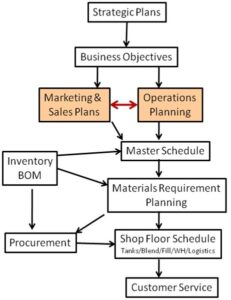Sales & Operations Planning (S&OP)
Definition (World Class S&OP, DH Sheldon)
- a monthly planning cycle where plans for both customer expectations & internal operations are reviewed for accuracy, process accountability, lessons learnt, and future risk management.
- Plans are monitored, updated at specific times, and reviewed predictably.
- Process owners are defined with clarify, top-management expectations & roles are clearly understood, and measurements are not only reviewed but are visible to the organisation for communications & synchronization purpose”
Expected Benefits:
- Between demand & supply sides of the business – Significant improvements in communication & agreement on rules of engagement.
- better customer service with less inventory & shorter leadtime.
- Smoothing operations plan for better capacity utilisation and lower unit costs.
- Improve accountability on large projects and new product implementation
- Quicker identification of change required and more nimble reactions to market changes.
- Lower risks that affects customer service.
- Improved profitability.
THE PROCESS
Pre-Meeting Preparation (as pre-read)
- Incidents / Events affecting customer service (ie. OTIF + stockout, Quality (incl. product/packaging quality, delivery timeliness) Issues
- Sales plan (Customer Demand/Forecast/Promotions/Seasonal demand ie. Chinese New Yr, Ramadan, Summer/Winter/Monsoon Demand)
- Production plan (backlog clearance plan, plan supply resources, manpower OT)
- Inventory plan (slow moving stock to clear etc)
- Customer lead time plan (any changes in customers expectations, urgent orders, tenders)
- New product development & introduction plan (new CVPs/Labels(MUvsSBK/Carton designs) & product withdrawal
- Strategic initiative plan (ie. new filling line)
Meeting Agenda
- Incidents / Events – determine Root Causes
- Variations to sales plan
- Changes to supply & production + new products timing
- Existing & New Risks & Mitigation Actions on Pre-Read items
- Output
- Actions on Incidents / Events affecting customer service
- Changes in agreed sales
- Changes in previous plans
- Future actions and anticipated results
- Decisions to balance supply & demand (ie. urgent orders)
Attendees
- Chairman – sets agenda, invite participants
- Sales / Marketing Rep
- Customer Service Rep
- Production & Planning Rep
- Facilitator (timekeeper, minutes taker)
Quick links:
